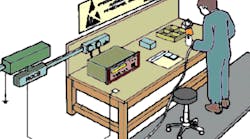Why Does The Internet of Things Need Different Wireless Standards?
The exploding global market for wirelessly interconnected devices has RF/microwave companies working diligently to develop technologies and create solutions for an Internet of Things (IoT) world. Key to the process is choosing the right wireless protocols and wireless networking technology when implementing IoT solutions. In an application note from Texas Instruments, titled “Wireless Connectivity for the Internet of Things,” the author provides an overview of the wireless technologies connecting commercial and industrial devices.
Among the critical factors cited are an IoT solution’s network range and topology. In terms of network ranges, choices include personal-area networks (PANs), local-area networks (LANs), neighborhood-area networks (NANs), and wide-area networks (WANs). Different technologies will better suit the key features of each network range, though. For example, Bluetooth is a common solution for PAN systems, but isn’t as well equipped for LAN systems (unlike WiFi).
Power and noise are the main limiting factors for throughput and range. As a result, each wireless technology leverages a variety of techniques to balance throughput and range with respect to its application. Generally, a network with a wider range will require more transmit power. Also, the maximum data rate of transmission will be lower.
A mesh network topology can be created to increase a network’s range without boosting the power and coverage area of a single node. A mesh network differs from a star network in that all of the nodes of a mesh network can exchange data to each other. They can even hop data from one node through another, and then onto the third node.
Many IoT and wireless-networking companies lack the resources or justification for producing their own proprietary wireless-networking standard. As a result, they must choose from already existing common standards. From sub-1-GHz to ZigBee/Bluetooth, the various wireless-networking standards each have strengths in different application spaces. They also operate with different network topologies in mind. The latest device concepts, for example, have configurable RF front-ends capable of multiple wireless standards, high-security systems, and ease of integration.
Texas Instruments, 12500 TI Boulevard Dallas, Texas 75265, 972-995-2011


